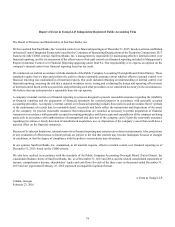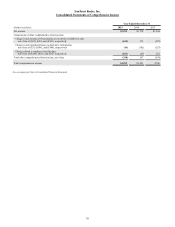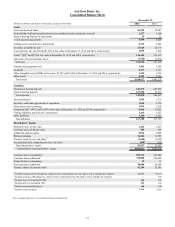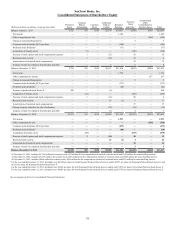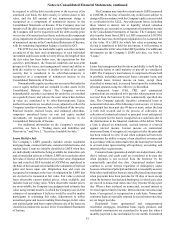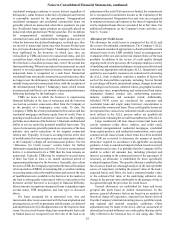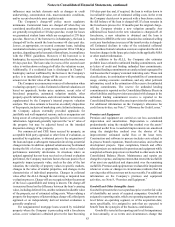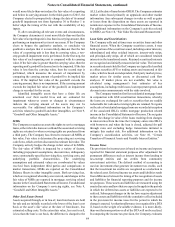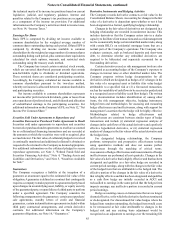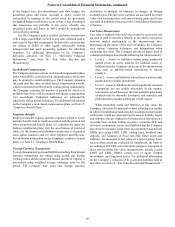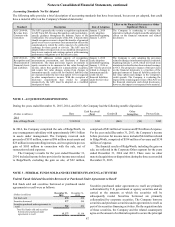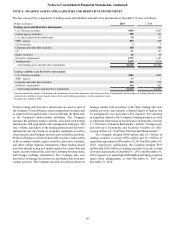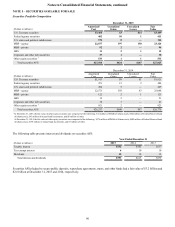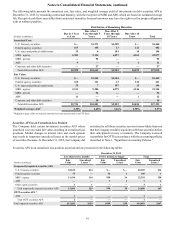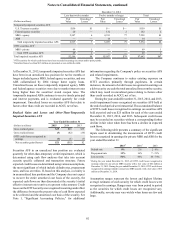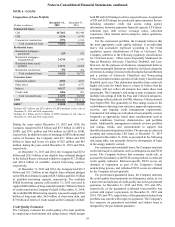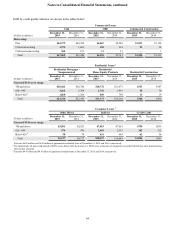SunTrust 2015 Annual Report Download - page 112
Download and view the complete annual report
Please find page 112 of the 2015 SunTrust annual report below. You can navigate through the pages in the report by either clicking on the pages listed below, or by using the keyword search tool below to find specific information within the annual report.Notes to Consolidated Financial Statements, continued
84
would more-likely-than-not reduce the fair value of a reporting
unit below its carrying amount. In the third quarter of 2015, the
Company elected to prospectively change the date of its annual
goodwill impairment test from September 30 to October 1 to
better align the timing of the test with the availability of key
inputs.
If, after considering all relevant events and circumstances,
the Company determines it is not more-likely-than-not that the
fair value of a reporting unit is less than its carrying amount, then
performing an impairment test is not necessary. If the Company
elects to bypass the qualitative analysis, or concludes via
qualitative analysis that it is more-likely-than-not that the fair
value of a reporting unit is less than its carrying value, a two-
step goodwill impairment test is performed. In the first step, the
fair value of each reporting unit is compared with its carrying
value. If the fair value is greater than the carrying value, then the
reporting unit's goodwill is deemed not to be impaired. If the fair
value is less than the carrying value, then the second step is
performed, which measures the amount of impairment by
comparing the carrying amount of goodwill to its implied fair
value. If the implied fair value of the goodwill exceeds the
carrying amount, there is no impairment. If the carrying amount
exceeds the implied fair value of the goodwill, an impairment
charge is recorded for the excess.
Identified intangible assets that have a finite life are
amortized over their useful lives and are evaluated for
impairment whenever events or changes in circumstances
indicate the carrying amount of the assets may not be
recoverable. For additional information on the Company’s
activities related to goodwill and other intangibles, see Note 9,
“Goodwill and Other Intangible Assets.”
MSRs
The Company recognizes as assets the rights to service mortgage
loans, either when the loans are sold and the associated servicing
rights are retained or when servicing rights are purchased from
a third party. The Company has elected to measure all MSRs at
fair value. Fair value is determined by projecting net servicing
cash flows, which are then discounted to estimate fair value. The
Company actively hedges the change in fair value of its MSRs.
The fair value of MSRs is impacted by a variety of factors,
including prepayment assumptions, discount rates, delinquency
rates, contractually specified servicing fees, servicing costs, and
underlying portfolio characteristics. The underlying
assumptions and estimated values are corroborated by values
received from independent third parties and comparisons to
market transactions. MSRs are reported on the Consolidated
Balance Sheets in other intangible assets. Both servicing fees,
which are recognized when they are received, and changes in the
fair value of MSRs are reported in mortgage servicing related
income in the Consolidated Statements of Income. For additional
information on the Company’s servicing rights, see Note 9,
“Goodwill and Other Intangible Assets.”
Other Real Estate Owned
Assets acquired through, or in lieu of, loan foreclosure are held
for sale and are initially recorded at the lower of the loan’s cost
basis or the asset’s fair value at the date of foreclosure, less
estimated selling costs. To the extent fair value, less cost to sell,
is less than the loan’s cost basis, the difference is charged to the
ALLL at the date of transfer into OREO. The Company estimates
market values based primarily on appraisals and other market
information. Any subsequent changes in value as well as gains
or losses from the disposition on these assets are reported in
noninterest expense in the Consolidated Statements of Income.
For additional information on the Company's activities related
to OREO, see Note 18, “Fair Value Election and Measurement.”
Loan Sales and Securitizations
The Company sells and at times may securitize loans and other
financial assets. When the Company securitizes assets, it may
hold a portion of the securities issued, including senior interests,
subordinated and other residual interests, interest-only strips,
and principal-only strips, all of which are considered retained
interests in the transferred assets. Retained securitized interests
are recognized and initially measured at fair value. The interests
in securitized assets held by the Company are typically classified
as either securities AFS or trading assets and measured at fair
value, which is based on independent, third party market prices,
market prices for similar assets, or discounted cash flow
analyses. If market prices are not available, fair value is
calculated using management’s best estimates of key
assumptions, including credit losses, loan repayment speeds, and
discount rates commensurate with the risks involved.
The Company transfers first lien residential mortgage loans
in conjunction with GSE securitization transactions, whereby
the loans are exchanged for cash or securities that are readily
redeemable for cash and servicing rights are retained. Net gains
on the sale of residential mortgage loans are recorded at inception
of the associated IRLCs within mortgage production related
income in the Consolidated Statements of Income. The net gains
reflect the change in value of the loans resulting from changes
in interest rates from the time the Company enters into IRLCs
with borrowers and when the loan is closed, adjusted for pull
through rates and excluding hedge transactions initiated to
mitigate this market risk. For additional information on the
Company’s securitization activities, see Note 10, “Certain
Transfers of Financial Assets and Variable Interest Entities.”
Income Taxes
The provision for income taxes is based on income and expense
reported for financial statement purposes after adjustment for
permanent differences such as interest income from lending to
tax-exempt entities and tax credits from community
reinvestment activities. The deferral method of accounting is
used on investments that generate investment tax credits, such
that the investment tax credits are recognized as a reduction to
the related asset. Deferred income tax assets and liabilities result
from differences between the timing of the recognition of assets
and liabilities for financial reporting purposes and for income
tax purposes. These assets and liabilities are measured using the
enacted tax rates and laws that are expected to apply in the periods
in which the deferred tax assets or liabilities are expected to be
realized. Subsequent changes in the tax laws require adjustment
to these assets and liabilities with the cumulative effect included
in the provision for income taxes for the period in which the
change is enacted. A valuation allowance is recognized for a DTA
if, based on the weight of available evidence, it is more-likely-
than-not that some portion or all of the DTA will not be realized.
In computing the income tax provision, the Company evaluates


